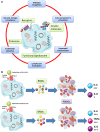Are Platelets Cells? And if Yes, are They Immune Cells?
- PMID: 25750642
- PMCID: PMC4335469
- DOI: 10.3389/fimmu.2015.00070
Are Platelets Cells? And if Yes, are They Immune Cells?
Abstract
Small fragments circulating in the blood were formally identified by the end of the nineteenth century, and it was suggested that they assisted coagulation via interactions with vessel endothelia. Wright, at the beginning of the twentieth century, identified their bone-marrow origin. For long, platelets have been considered sticky assistants of hemostasis and pollutants of blood or tissue samples; they were just cell fragments. As such, however, they were acknowledged as immunizing (to specific HPA and HLA markers): the platelet's dark face. The enlightened face showed that besides hemostasis, platelets contained factors involved in healing. As early as 1930s, platelets entered the arsenal of medicines were transfused, and were soon manipulated to become a kind of glue to repair damaged tissues. Some gladly categorized platelets as cells but they were certainly not fully licensed as such for cell physiologists. Actually, platelets possess almost every characteristic of cells, apart from being capable of organizing their genes: they have neither a nucleus nor genes. This view prevailed until it became evident that platelets play a role in homeostasis and interact with cells other than with vascular endothelial cells; then began the era of physiological and also pathological inflammation. Platelets have now entered the field of immunity as inflammatory cells. Does assistance to immune cells itself suffice to license a cell as an "immune cell"? Platelets prove capable of sensing different types of signals and organizing an appropriate response. Many cells can do that. However, platelets can use a complete signalosome (apart from the last transcription step, though it is likely that this step can be circumvented by retrotranscribing RNA messages). The question has also arisen as to whether platelets can present antigen via their abundantly expressed MHC class I molecules. In combination, these properties argue in favor of allowing platelets the title of immune cells.
Keywords: cell biology; cell physiology; cytokines; hemostasis; immunopathology; immunophysiology; platelets.
Figures

References
-
- Gazzaniga V, Ottini L. The discovery of platelets and their function. Vesalius (2011) 7:22–6 Available from: http://www.biusante.parisdescartes.fr/ishm/vesalius/VESx2001x07x01x022x0...
Publication types
LinkOut - more resources
Full Text Sources
Other Literature Sources
Research Materials

